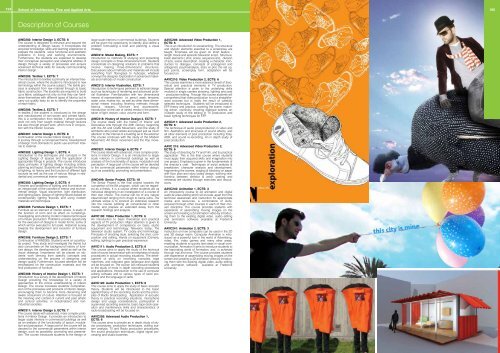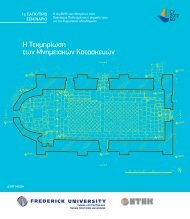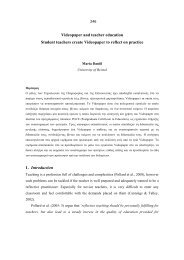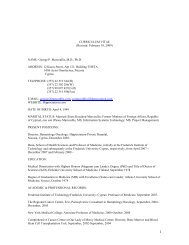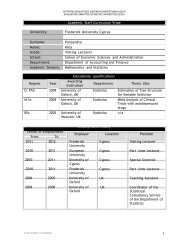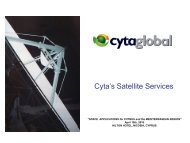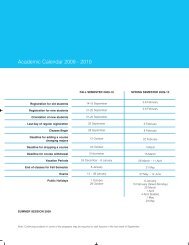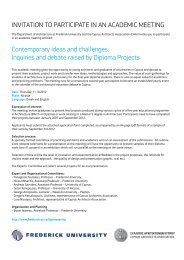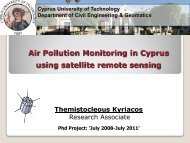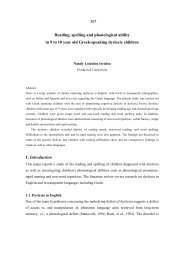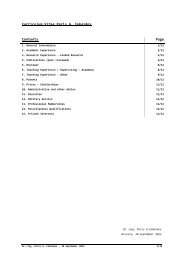Department of Architecture - Frederick University
Department of Architecture - Frederick University
Department of Architecture - Frederick University
You also want an ePaper? Increase the reach of your titles
YUMPU automatically turns print PDFs into web optimized ePapers that Google loves.
154<br />
School <strong>of</strong> <strong>Architecture</strong>, Fine and Applied Arts 155<br />
Description <strong>of</strong> Courses<br />
AIND202: Interior Design 3, ECTS: 8<br />
The course is designed to enhance and expand the<br />
understanding <strong>of</strong> design issues. It incorporates the<br />
acquired knowledge, skills and learning experience to<br />
prepare the students solve functional and aesthetic<br />
problems in living and working environments.<br />
Furthermore, the students are expected to develop<br />
their conceptual perception and analytical abilities <strong>of</strong><br />
design through a variety <strong>of</strong> processes and acquire<br />
advanced technical skills for visually communicating<br />
interior design.<br />
AIND205: Textiles 1, ECTS: 7<br />
The introduction to textiles is primarily an intense theoretical<br />
course, where the student is introduced to new<br />
terminology within the course subject. The textile process<br />
is analyzed from raw material through to basic<br />
fabric construction. The students are required to build<br />
up a fabric catalogue not only so that they can familiarize<br />
themselves with different types <strong>of</strong> fabrics but to<br />
carry out quality tests so as to identify the properties<br />
<strong>of</strong> each fabric.<br />
AIND206: Textiles 2, ECTS: 7<br />
In textiles 2 the student is introduced to the design<br />
and manufactured <strong>of</strong> non-woven and printed fabric;<br />
this is a combination from textiles 1 where students<br />
work not only from taught material through lectures<br />
but also through project work, which runs in conjunction<br />
with the Interior courses.<br />
AIND301: Interior Design 4, ECTS: 8<br />
Continuation <strong>of</strong> the course Interior Design 3<br />
A journey through a conceptual theme. Development<br />
<strong>of</strong> design, from domestic to public use and from internal<br />
to external.<br />
AIND302: Lighting Design 1, ECTS: 4<br />
Introduction to the techniques and concepts in the<br />
Lighting Design <strong>of</strong> spaces and the application <strong>of</strong><br />
appropriate fittings in projects. The course introduces<br />
basic principles <strong>of</strong> lighting design including criteria,<br />
planning and layout. Students will be taught the theory<br />
<strong>of</strong> lighting, its history and the function <strong>of</strong> different light<br />
sources as well as the use <strong>of</strong> various fittings in residential<br />
and commercial interior spaces.<br />
AIND303: Lighting Design 2, ECTS: 4<br />
Theories and problems <strong>of</strong> lighting and illumination as<br />
an integral part <strong>of</strong> the concept <strong>of</strong> interior and environmental<br />
design. Visual discomfort, light distribution,<br />
and lighting plans. Design <strong>of</strong> lighting fixtures based on<br />
contemporary lighting theories and using modern<br />
materials and techniques.<br />
AIND305: Furniture Design 1, ECTS: 7<br />
Furniture as an element <strong>of</strong> interior space. A study <strong>of</strong><br />
the function <strong>of</strong> form and its effect on furnishings.<br />
Investigating and utilizing modern material techniques<br />
<strong>of</strong> furniture production. Problems provide opportunity<br />
for the execution <strong>of</strong> designs in model forms, some <strong>of</strong><br />
which will be executed in full scale. Historical survey<br />
towards the development and evolution <strong>of</strong> furniture<br />
design.<br />
AIND306: Furniture Design 2, ECTS: 7<br />
Continuation <strong>of</strong> AIND305. Students work on a particular<br />
project. They study and investigate the theme but<br />
also concentrate on the background history <strong>of</strong> furniture<br />
design, the development <strong>of</strong> detail as well as the<br />
visual drawings. Importance will be placed on students'<br />
work deriving from specific concepts and<br />
understanding on the process <strong>of</strong> designing and<br />
design quality. Furthermore, focused attention will be<br />
emphasized on the construction materials and the<br />
final production <strong>of</strong> furniture.<br />
AIND308: History <strong>of</strong> Interior Design 1, ECTS: 7<br />
Introduction to a survey <strong>of</strong> the development <strong>of</strong> Interior<br />
Design providing the knowledge <strong>of</strong> a variety <strong>of</strong><br />
approaches to the critical understanding <strong>of</strong> Interior<br />
Design. The course increases students' comprehension<br />
<strong>of</strong> the processes and products <strong>of</strong> interior design,<br />
encouraging them to become more discerning and<br />
aware consumers <strong>of</strong> culture. Attention is focused on<br />
the meaning and context <strong>of</strong> current and past artistic<br />
and cultural activities, in industrialized and nonindustrial<br />
societies.<br />
AIND311: Interior Design 5, ECTS: 7<br />
The course deals with advanced, more complex problems<br />
in Interior Design. It provides an introduction to<br />
larger scale interiors in commercial buildings as well<br />
as an analysis <strong>of</strong> the functionality <strong>of</strong> space, modulation<br />
and perception. A large part <strong>of</strong> the course will be<br />
devoted to the commercial parameters within interior<br />
design, such as possibility, promoting and presentation.<br />
The course introduces students to the design <strong>of</strong><br />
large scale interiors in commercial buildings. Students<br />
will be given the opportunity to identify and define a<br />
problem formulating a brief and planning a visual<br />
strategy.<br />
AIND312: Model Making, ECTS: 7<br />
Introduction to methods <strong>of</strong> studying and presenting<br />
design concepts in three-dimensional form. Students<br />
concentrate on designing solutions to problems that<br />
involve making three-dimensional structures.<br />
Discussions about methods and materials will include<br />
everything from fiber-glass to hubcaps; whatever<br />
conveys the designer. Exploration in advanced materials<br />
and methods <strong>of</strong> model construction.<br />
AIND313: Interior Illustration, ECTS: 7<br />
Introduction to techniques pertinent to editorial design<br />
such as techniques <strong>of</strong> rendering and advanced pictorial<br />
illustration. Familiarization with two dimensional<br />
means <strong>of</strong> representation i.e. pencil, wash, tempera,<br />
water color, marker etc. as well as other three dimensional<br />
means including finishing methods through<br />
fabrics, drapery, furniture and accessories.<br />
Introduction to the use <strong>of</strong> varied media in the presentation<br />
<strong>of</strong> light, texture, color, volume and form.<br />
AIND318: History <strong>of</strong> Interior Design 2, ECTS: 7<br />
The course deals with the history <strong>of</strong> Interior and<br />
Decorative Arts through the 20th century, beginning<br />
with the Art and Crafts Movement, and the study <strong>of</strong><br />
architects who joined artists and played just as much<br />
attention to the internal <strong>of</strong> a building as to the external.<br />
The course continues with the study <strong>of</strong> the Modern<br />
Movement, Art Deco movement and the Pop movement.<br />
AIND321: Interior Design 6, ECTS: 7<br />
The course deals with advanced, more complex problems<br />
in Interior Design. It is an introduction to larger<br />
scale interiors in commercial buildings as well as<br />
analysis <strong>of</strong> the functionality <strong>of</strong> space, modulation and<br />
perception. A large part <strong>of</strong> the course will be devoted<br />
to the commercial parameters within interior design,<br />
such as possibility, promoting and presentation.<br />
AIND499: Senior Project, ECTS: 18<br />
The Senior Project is the final project towards the<br />
completion <strong>of</strong> the BA program, which can be regarded<br />
as a thesis. It is a course where students act as<br />
individual designers in an investigation <strong>of</strong> a course <strong>of</strong><br />
their own choice. The course can be <strong>of</strong> any nature/<br />
idea/concept ranging from drugs to kama sutra. The<br />
ultimate scope is to conduct an extensive research<br />
into the course (utilizing all conventional or other<br />
media) and prepare an extended essay from the<br />
research findings and analysis.<br />
AAVC100: Video Production 1, ECTS: 6<br />
An introduction to basic theoretical and practical<br />
aspects <strong>of</strong> TV production. Major attention is given to<br />
the development <strong>of</strong> competence on basic studio<br />
equipment and terminology. Television today; The<br />
television studio system; TV codes and terminology;<br />
Principles <strong>of</strong> shooting style, selecting the shot, composition<br />
and editing; Hands on equipment (Camera,<br />
editing, lighting) to gain practical experience.<br />
AAVC111: Audio Production 2, ECTS: 6<br />
This course aims to apply the study <strong>of</strong> the technical<br />
side <strong>of</strong> sound transmission with an emphasis <strong>of</strong> studio<br />
procedures in actual recording situations. The development<br />
<strong>of</strong> skills on recording consoles, tape<br />
machines, and outboard gear (analogue and digital)<br />
will be focused on. The course will introduce students<br />
to the study <strong>of</strong> more in depth recording procedures<br />
and applications. Introduction to the use <strong>of</strong> computer<br />
editing s<strong>of</strong>tware and to various types <strong>of</strong> radio programs<br />
and the language <strong>of</strong> radio.<br />
AAVC120: Audio Production 1, ECTS: 6<br />
This course aims to apply the study <strong>of</strong> basic acoustic<br />
theory. Students will be introduced to the basic<br />
applied theory <strong>of</strong> the recording studio and the principles<br />
<strong>of</strong> Radio broadcasting. Application <strong>of</strong> acoustic<br />
theory to practical recording situations, microphone<br />
design and usage considerations, participation in<br />
supervised recording sessions, basic tape deck operation<br />
and maintenance skills and characteristics <strong>of</strong><br />
radio broadcasting will be focused on.<br />
AAVC203: Advanced Audio Production 1,<br />
ECTS: 6<br />
This course aims to provide an in depth study <strong>of</strong> studio<br />
procedures, production techniques, editing system<br />
analysis, TV and Radio production procedures,<br />
film sound production techniques, digital signal processing<br />
and studio business.<br />
AAVC205: Advanced Video Production 1,<br />
ECTS: 6<br />
This is an introduction to screenwriting. The structural<br />
and stylistic elements essential to a screenplay are<br />
taught. Emphasis will be given on short feature -<br />
length movie and episodic television script. Structure,<br />
basic elements ( shot, scene, sequence etc), division<br />
<strong>of</strong> acts, scene description, creating a character, introduction<br />
to dialogue, concepts <strong>of</strong> protagonist and<br />
antagonist, psychoanalysis, story vs plot, the set up,<br />
plot points, screenplay form, adaptation will be<br />
focused on.<br />
AAVC210: Video Production 2, ECTS: 6<br />
This course examines a more advance levedl <strong>of</strong> theoretical<br />
and practical elements in TV production.<br />
Special attention is given to the underlying skills<br />
involved in single camera shooting, lighting and post<br />
- production editing. Through this course students will<br />
comprehend that video production is not a straightforward<br />
process but is really the result <strong>of</strong> carefully<br />
selected techniques. Students will be introduced to<br />
EFP theory and practice, covering the scene, matching<br />
action, continuity, shooting dialogue scenes, an<br />
in-depth study <strong>of</strong> the editing in TV production and<br />
basic lighting techniques for EFP.<br />
AAVC211: Advanced Audio Production 2,<br />
ECTS: 6<br />
The technique <strong>of</strong> audio post-production in video and<br />
film. Aesthetics and structures <strong>of</strong> sound effects, and<br />
all other elements <strong>of</strong> post production including foley,<br />
ADR, and sound re-recording. An in depth study <strong>of</strong><br />
post production.<br />
AAVC 215: Advanced Video Production 2,<br />
ECTS: 6<br />
The study <strong>of</strong> directing for TV and Film, and its practical<br />
application. This is the final course where students<br />
must apply their acquired skills and imagination into<br />
one project. Emphasis is given in the fundamentals <strong>of</strong><br />
the director’s craft. Techniques <strong>of</strong> script analysis &<br />
breakdown, character analysis and development,<br />
fragmenting the scenes, staging & blocking on paper<br />
with floor plan and story board design, working relationship<br />
between director & actor, casting and<br />
rehearsal are studied through exercises and discussions.<br />
AAVC240: Animation 1, ECTS: 3<br />
An introductory course to 2d animation and digital<br />
audio & video editing which will include ,apart from the<br />
technical awareness and instruction for appropriate<br />
media and resources, a combination <strong>of</strong> skills,<br />
acquired through other courses in each <strong>of</strong> their chosen<br />
discipline. The course provides students with<br />
experience <strong>of</strong> assembling moving images on the<br />
screen and creating a 2d animation video by introducing<br />
them to the existing digital video, audio editing<br />
and animation s<strong>of</strong>tware available at <strong>Frederick</strong><br />
<strong>University</strong>.<br />
AAVC241: Animation 2, ECTS: 3<br />
Instruction on how computers can be used in the 2D<br />
and 3D design realm. Computer Animation is introduced<br />
as a powerful tool in the world <strong>of</strong> Advertising,<br />
video, film, video games and many other areas,<br />
enabling students to quickly test ideas in visual communication.<br />
Animation II aims to introduce students to<br />
the fascinating world <strong>of</strong> Animation, and is achieved<br />
through trial and error. The course provides students<br />
with experience <strong>of</strong> assembling moving images on the<br />
screen and creating a 3D animation video by introducing<br />
them with the existing digital video, audio editing<br />
and animation s<strong>of</strong>tware available at <strong>Frederick</strong><br />
<strong>University</strong>.


